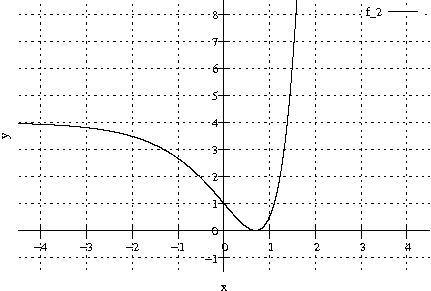0.0.1 ↑ 80. Hausaufgabe
0.0.1.1 ↑ Analysis-Buch Seite 113, Aufgabe 38
\mathrm{f}_t(x) = \left(e^x - t\right)^2; \quad D_{\mathrm{f}_t} = \mathds{R}; \quad t > 0;
- a)
Berechne abhängig von t: Schnittpunkte des Graphen und der Koordinatenachsen, Asymptoten, Tief- und Wendepunkte.
\mathrm{f}_t(0) = \left(1 - t\right)^2; \quad S_y(0, \left(1-t\right)^2);
\mathrm{f}_t(x) = \left(e^x - t\right)^2 = 0; ⇒ e^x = t; ⇒ x = \ln t; \quad S_x(\ln t, 0);
\lim\limits_{x \to \infty} \mathrm{f}_t(x) = \infty;
\lim\limits_{x \to -\infty} \mathrm{f}_t(x) = \lim\limits_{x \to -\infty} e^{2x} - 2 e^x t + t^2 = 0 - 0 + t^2 = t^2;
Asymptotengleichung: y = t^2;
\mathrm{f}_t'(x) = 2 \left(e^x - t\right) \cdot e^x;
ln t|----------+---------->
---------------------> e^x- - - - - *----------> e^x - t
- 0 +
P_{\text{TIP}}(\ln t, 0);
\mathrm{f}_t''(x) = 2 e^x \left(e^x - t\right) + 2 e^x e^x = 2 e^x \left(e^x - t + e^x\right) = 0; ⇔
e^x - t + e^x = 2 e^x - t = 0; ⇔ x = \ln \frac{t}{2};
P_{\text{WEP}}\!\left(\ln \frac{t}{2}, \frac{t^2}{4}\right);
- b)
Zeichne G_{\mathrm{f}_2} im Bereich \left[-4, \frac{3}{2}\right].

- c)
Berechne die Koordinaten des Schnittpunkts S von G_{\mathrm{f}_t} und der zugehörigen Asymptote.
Auf welcher Kurve liegen diese Schnittpunkte?
t^2 = \mathrm{f}_t(x) = \left(e^x - t\right)^2;
\pm t = e^x - t;
\pm t + t = e^x;
Zwei Fälle:
0 = e^x; → keine Lösung
2t = e^x; ⇔ x = \ln 2t; \quad S(\ln 2t, t^2);
\lambda := \ln 2t; ⇔ e^\lambda = 2t; ⇔ \frac{1}{4} e^{2 \lambda} = t^2;
Kurve der Schnittpunkte: \mathrm{k}(\lambda) = \frac{1}{4} e^{2 \lambda};
0.0.1.2 ↑ Analysis-Buch Seite 114, Aufgabe 54
Harte \beta-Strahlen werden zu 80 \,\% in einer 1 \,\mathrm{mm} dicken Aluminiumschicht absorbiert.
- a)
Bei welcher Schichtdicke werden 50 \,\% absorbiert?
N(d) = N_0 \cdot \left(20 \,\%\right)^{d / 1 \,\mathrm{mm}};
N(d_{50 \,\%}) = N_0 \cdot \left(20 \,\%\right)^{d_{50 \,\%} / 1 \,\mathrm{mm}} = 50 \,\% \cdot N_0; ⇔
d_{50 \,\%} / 1 \,\mathrm{mm} = \log_{20 \,\%} 50 \,\%; ⇔ d_{50 \,\%} = 1 \,\mathrm{mm} \cdot \log_{20 \,\%} 50 \,\% \approx 0{,}4 \,\mathrm{mm};
- b)
Bei welcher Schichtdicke dringt noch 1 \,\% hindurch?
N(d_{1 \,\%}) = N_0 \cdot \left(20 \,\%\right)^{d_{1 \,\%} / 1 \,\mathrm{mm}} = 1 \,\% \cdot N_0; ⇔
d_{1 \,\%} / 1 \,\mathrm{mm} = \log_{20 \,\%} 1 \,\%; ⇔ d_{1 \,\%} = 1 \,\mathrm{mm} \cdot \log_{20 \,\%} 1 \,\% \approx 1{,}4 \,\mathrm{mm};
- c)
Welcher Anteil der Strahlung wird von einer 0{,}5 \,\mathrm{mm} starken Alufolie verschluckt?
1 - N(0{,}5 \,\mathrm{mm}) / N_0 = 1 - \left(20 \,\%\right)^{0{,}5 \,\mathrm{mm} / 1 \,\mathrm{mm}} \approx 55 \,\%;